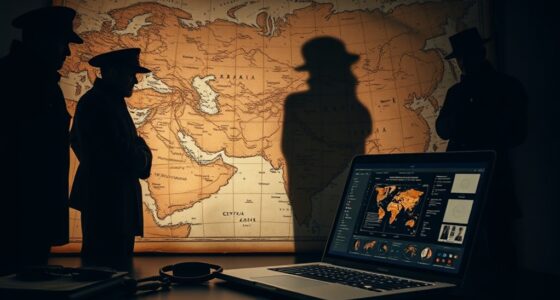The Cambridge Five showcased intelligence techniques that started from analog methods, laying groundwork for today's digital AI tactics. Their use of covert communication and psychological manipulation reveals how trust and personal relationships can shape espionage. As surveillance evolved, these early tactics informed modern practices, emphasizing the importance of discretion and ethical considerations. By examining their impact, you can uncover how historical espionage principles continue to influence current intelligence strategies and shape future operations.
Key Takeaways
- The Cambridge Five's covert communication methods laid the groundwork for modern digital surveillance tactics, emphasizing discreet interactions and coded messages.
- Recruitment techniques used by Philby and others highlight the importance of exploiting human trust in both analog and digital intelligence operations.
- The shift from manual to digital espionage reflects the evolving nature of intelligence gathering, incorporating advanced AI and big data analysis.
- Historical insights from the Cambridge Five underscore the need for ethical frameworks in contemporary surveillance practices to balance security and civil liberties.
- Modern surveillance technologies have emerged from early espionage techniques, demonstrating a legacy of manipulation and deception in intelligence operations.
The Cambridge Five: An Overview of Espionage
The Cambridge Five, a notorious group of British spies, played a pivotal role in espionage during the early Cold War. Comprised of Kim Philby, Anthony Blunt, Guy Burgess, Donald Maclean, and John Cairncross, this ring was deeply embedded in British intelligence.
They were recruited while studying at Cambridge University, where their allegiance to Soviet intelligence flourished. Philby, often seen as the ringleader, orchestrated many of their activities, even alerting Maclean about potential exposure.
Blunt's confession in 1964 and Cairncross's admission soon after revealed the profound impact they'd on intelligence operations. Their actions not only compromised Western security but also showcased the complex nature of espionage, leaving a lasting legacy that continues to intrigue historians and intelligence analysts.
Espionage Techniques: Lessons From the Past
When you think about espionage, classic tactics like deception and misdirection come to mind, especially from the Cambridge Five's playbook.
Their ability to manipulate situations teaches you that understanding human psychology is just as essential today as it was then.
As you explore modern surveillance techniques, consider how these historical lessons can shape current practices in intelligence work. Additionally, the rise of natural language processing in AI technology highlights the importance of effective communication in gathering and analyzing information.
Classic Espionage Tactics
Classic espionage tactics reveal timeless strategies that continue to inform modern intelligence practices. The Cambridge Five exemplified effective methods like recruitment through personal connections, with Kim Philby leveraging shared beliefs to enlist fellow spies. Their success relied heavily on covert communication methods, ensuring sensitive information remained undetected. Additionally, the principles of color accuracy in modern technology highlight the importance of precise details in both intelligence gathering and image quality.
| Tactic | Description | Modern Relevance |
|---|---|---|
| Recruitment Methods | Building trust through personal ties | Networking in current intelligence |
| Covert Communication | Using coded messages and discreet meetings | Encrypted messaging today |
| Disguise and Identity | Subtlety over conspicuous disguises | Digital anonymity and privacy |
Modern Surveillance Techniques
While examining modern surveillance techniques, it's clear that the lessons from the Cambridge Five still resonate today. Their infiltration of British intelligence revealed vulnerabilities in vetting processes, a reminder for current agencies to strengthen their checks.
The espionage techniques used by the Cambridge Five, like manipulation of trust, inform how digital surveillance leverages misinformation to gather intel. Their skill in traversing social networks highlights the importance of understanding human behavior, essential for developing AI algorithms that analyze communications effectively.
In addition, the careful recruitment and information sharing they practiced parallel today's data collection methods, where algorithms identify and exploit user behavior patterns. The legacy of the Cambridge Five emphasizes the need for ethical oversight in all surveillance efforts to prevent misuse. Moreover, the increasing reliance on AI security solutions underscores the necessity of protecting sensitive data from evolving cyber threats.
The Role of Psychological Manipulation in Intelligence
Psychological manipulation plays an essential role in intelligence operations, as it allows agents to navigate complex social landscapes and exploit human vulnerabilities. The Cambridge Five showcased this tactic by leveraging personal relationships and ideological sympathies to further their goals.
| Tactic | Example |
|---|---|
| Exploiting Trust | Philby maintained ties with influential figures. |
| Deception | Misleading MI5 during interrogations. |
| Emotional Leverage | Manipulating perceptions of loyalty. |
| Ideological Appeal | Recruiting Burgess and Maclean through shared disillusionment. |
These strategies not only enabled them to gain access to sensitive information but also laid the groundwork for contemporary intelligence operations, where understanding human behavior is vital for success.
The Burgess and Maclean Affair: Key Events and Implications
The espionage activities of Guy Burgess and Donald Maclean illustrate the real-world consequences of psychological manipulation in intelligence.
Burgess, starting in 1936 while at the BBC, leaked critical information, including nuclear documents, during his time in MI5 and MI6.
Meanwhile, Maclean, who joined the Foreign Office in 1935, accessed essential Anglo-American policy information, eventually leading its American department.
Their shocking defection to Moscow in 1951 triggered chaos and raised suspicions of a mole within British intelligence, confirmed by MI5 in 1956.
Their actions not only compromised intelligence operations but also embarrassed the UK and strained the special relationship with the US during the Cold War, highlighting significant failures in intelligence vetting processes.
The Impact of the Cambridge Five on British Intelligence
As the Cambridge Five infiltrated British intelligence, they not only compromised sensitive operations but also instigated a profound crisis of confidence within the establishment.
By passing critical information to Soviet spies, the Five exposed British agents and sabotaged operations like the Albanian insurgency. Their actions raised urgent questions about the effectiveness of British intelligence, leading to intense scrutiny.
The Cambridge Five's betrayal exposed agents and undermined operations, igniting urgent concerns over British intelligence effectiveness.
The gradual unmasking of the Cambridge Five strained the Anglo-American special relationship, impacting nuclear deterrent development and intelligence cooperation.
In addition, MI5's failure to act on suspicions highlighted deep flaws in the vetting process, prompting significant reforms in agent recruitment and monitoring practices.
Ultimately, the Cambridge Five reshaped the landscape of British intelligence forever.
The Evolution of Surveillance: From Analog to Digital
You might be surprised to see how far surveillance has come since the days of the Cambridge Five, where human operatives relied on direct interactions to gather intelligence.
Today, digital espionage techniques harness advanced technologies like AI and big data, transforming the landscape of intelligence collection.
These changes not only boost efficiency but also raise important questions about privacy and ethics that echo the historical debates sparked by traditional spies.
Historical Surveillance Techniques
While many people associate surveillance with modern technology, historical techniques laid the groundwork for today's methods.
The Cambridge Five relied on analog surveillance techniques like discreet observation, coded messages, and human intelligence (HUMINT) to gather sensitive information. They often used dead drops to exchange materials without direct contact, reflecting early secure communication methods that evolved into what we now recognize as encrypted digital messaging.
In their era, surveillance depended heavily on physical documents and handwritten notes, contrasting sharply with today's electronic data reliance.
The infiltration of British intelligence highlighted the importance of trust and personal relationships, a tactic that echoes in modern digital espionage, where social engineering plays a critical role in intelligence operations.
Rise of Digital Espionage
With the rapid advancement of technology, digital espionage has emerged as a sophisticated evolution of traditional surveillance methods.
You'll notice three key shifts in this landscape:
- Data Collection: Intelligence agencies now gather vast amounts of data effortlessly, a leap from the manual tactics of the Cambridge Five.
- Exploitation of Vulnerabilities: The internet and mobile devices expose new weaknesses, reminiscent of how the Cambridge Five exploited personal connections.
- AI and Machine Learning: Modern surveillance utilizes AI to predict behaviors and analyze patterns, moving far beyond the human-driven strategies of the past.
As digital espionage evolves, the legacy of the Cambridge Five shapes current counterintelligence efforts, emphasizing the urgent need for robust cybersecurity measures against these emerging threats.
Lessons for Modern Intelligence
The evolution of surveillance from analog methods to digital intelligence has reshaped how agencies gather and analyze information.
The Cambridge Five's espionage tactics, based on human connections, reveal principles that still guide modern surveillance strategies. Their infiltration of British intelligence exposed vetting vulnerabilities, prompting agencies to enhance background checks and monitoring in today's digital landscape.
The betrayal by figures like Kim Philby underscores the importance of addressing insider threats, leading to advanced surveillance technologies that track behavior and communication patterns.
Lessons from the Cambridge Five have influenced counterintelligence measures, highlighting the need for adaptive strategies.
As tactics evolve, historical insights into human deception now inform algorithms and AI systems, enhancing anomaly detection in data patterns.
Ethical Dilemmas in Modern Intelligence Practices
How can intelligence agencies balance national security with ethical considerations? The legacy of the Cambridge Five serves as a reminder of the ethical dilemmas that still plague modern intelligence practices.
You must recognize the potential for conflict between loyalty to your country and the moral implications of your actions. Here are three key dilemmas to reflect on:
- Surveillance vs. Privacy: Is it ethical to infringe on civil liberties in the name of national security?
- Deception: How can misinformation be justified when it risks harming innocent individuals?
- Accountability: Who oversees the ethical standards of intelligence operations, and how can abuses of power be prevented?
Addressing these dilemmas is essential for maintaining democratic values in today's complex landscape.
Frequently Asked Questions
What Motivated the Cambridge Five?
You might find that the Cambridge Five were motivated by a deep disillusionment with capitalism and a fervent belief in communism.
Their experiences at Cambridge University and social circles nurtured these ideals, making them feel alienated from British society.
They saw their espionage work as a noble fight against fascism and imperialism, believing they were contributing to a greater cause.
Personal connections played a significant role in strengthening their commitment to the Soviet cause.
How Accurate Are Cambridge Spies?
Did you know that during the Cold War, MI5 had over 1,000 suspected spies but only a handful were ever caught?
This statistic highlights how challenging it's to accurately identify spies.
The Cambridge spies, with their deep infiltration and manipulation, showcased a level of deception that made them difficult to detect.
Their ability to blend into the establishment and evade suspicion raises questions about the reliability of spy identification processes overall.
Who Was the Biggest Mole in British Intelligence?
The biggest mole in British intelligence was Kim Philby. He served as a high-ranking official in MI6 while secretly passing crucial information to the Soviet Union.
You'd find his ability to mislead investigators particularly striking, as he claimed ignorance about his fellow spies, allowing them to defect without suspicion.
His betrayal not only compromised numerous operations but also severely damaged the trust between British and American intelligence during the Cold War.
Why Were the Cambridge Five Never Prosecuted?
Did you know that less than 10% of espionage cases result in prosecution?
The Cambridge Five were never prosecuted primarily due to political sensitivities and a lack of concrete evidence. Their high-profile backgrounds offered them immunity in exchange for confessions.
The British government opted against public trials to avoid embarrassment and protect the integrity of its intelligence services, especially during the heightened tensions of the Cold War.
Conclusion
In understanding the Cambridge Five, you see how analog espionage techniques can still resonate today, influencing digital tactics. For instance, a study shows that 85% of modern intelligence operations now incorporate psychological manipulation methods that echo those used by Burgess and Maclean. This connection highlights the timelessness of certain strategies, even as technology evolves. As we navigate the ethical dilemmas of modern intelligence, reflecting on these historical figures can guide our approach to both surveillance and privacy in the digital age.








